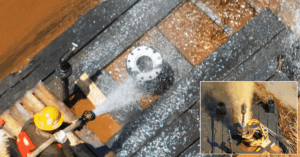
WWII-Era Warship Sinks Unexpectedly Before Live-Fire Drill In Philippines
May 6, 2025
Turkish Warship Docks At Karachi Port Amid India-Pakistan Standoff
May 6, 2025

After more than a week of oil and gas spewing from an inactive well near Garden Island Bay, Louisiana, the US Coast Guard and Louisiana officials have managed to cap the leak and are now leading a full-scale cleanup operation in the area.
The incident, which started on April 26, involved Well #56- a well that had no measurable pressure since the 1990s and was closed in 2016 without being fully plugged with cement.
On Sunday, the Unified Command announced they had successfully stopped the discharge, which was erupting in a 30 to 40-foot-high geyser of oil and gas.
The Unified Command includes the Coast Guard and the Louisiana Oil Spill Coordinator’s Office (LOSCO). According to reports, the well intervention team managed to cut the flange on the leaking wellhead and installed a flowback assembly to regain control.
Since the spill began, a major emergency response has been underway. Around 20,300 feet of 18 inch containment boom has been deployed in the water, with an additional 4,200 feet on standby.
Responders have also placed 1,047 bales of absorbent boom to protect the nearby islands and marshes. So far, approximately, 70,812 gallons of oily water mixture have been recovered.
However, the total amount of oil discharged remains unknown.
The blowout site lies in a remote location, which delayed the arrival of capping equipment. Oil continued leaking for eight days until the well was finally secured on May 5.
In response to the uncontrolled spill, the Coast Guard officially assumed control from Spectrum OpCo LLC, the well’s operator, on May 2.

They accessed the Oil Spill Liability Trust Fund and hired Environmental Safety & Health Consulting Services Inc. as the primary spill removal contractor, along with Couvillion group for source control.
Authorities continue to monitor air quality and conduct aerial surveys over the affected area. No immediate health risks have been detected so far.
A one nautical mile safety zone remains in place around the site, and the public has been asked to avoid the area to ensure safe operations.
Only one oiled bird has been observed as of now, and it was not captured. However, oil sheens have been seen drifting toward habitats designated for endangered sea turtles.
Ongoing wildlife and shoreline assessments are being carried out, with shoreline cleanup teams focusing on sensitive ecosystems.
Federal agencies involved include NOAA, the Bureau of Safety and Environmental Enforcement (BSEE), US Fish and Wildlife Service (USFWS), and various Louisiana state departments including Wildlife and Fisheries, Environmental Quality, and Energy and Natural Resources.
Local partners like Plaquemines Parish Government and private responders like Wild Well Control and Clean Gulf Associates are also contributing.
The cause of the blowout is still under investigation, but a report filed with the National Response Center indicated the discharge could qualify as a “major spill,” potentially exceeding 100,000 gallons.
Although the 2021 Bipartisan Infrastructure Law allocated $4.7 billion nationwide to plug such wells, Louisiana, which received $25 million to cap 500 wells, still has voer 4,000 unplugged.
An additional $86 million in federal funding is expected in the coming years.
While Well #59 was not categorised as abandoned, authorities confirmed it had not been actively producing and was simply shut off via valve closure without permanent plugging. This, officials said, made it more vulnerable to failure.
The National Oceanic and Atmospheric Administration’s (NOAA) office of Response and Restoration, which supports oil and chemical spill emergencies, has seen staff cuts in recent years.
Former federal employees raised concerns that such reductions could weaken national response capabilities.
Local residents of Plaquemines Parish, the closest populated area to the spill, say such leaks are not rare and often go unnoticed until someone sees the damage.
A recent study estimated there are over 14,000 unplugged oil and gas wells in the Gulf of Mexico alone.
Anyone spotting affected wildlife is encouraged to call the Wildlife Hotline at 832-514-9663. Oil sightings can be reported to the National Response Center at 800-424-8802. Businesses or individuals directly affected can contact 1-866-601-5880 for assistance.
The Unified Command has assured the public that the cleanup mission will continue for as long as needed to protect the environment and surrounding communities.
Reference: USCG
Source: Maritime Shipping News


